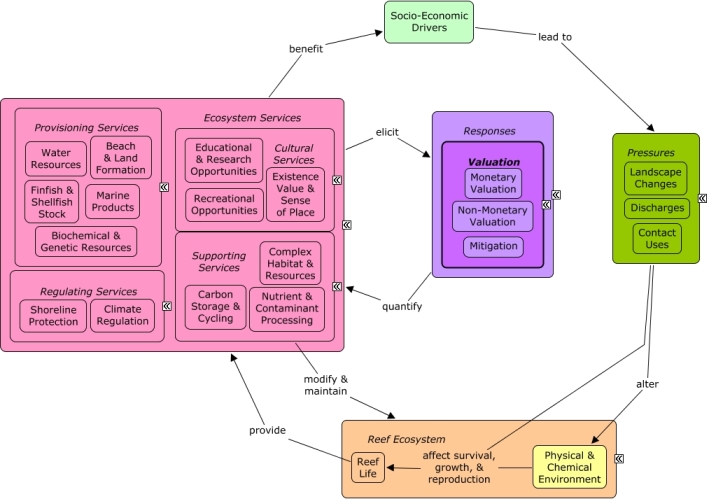ReefLink Database

Mitigation
Mitigation is an effort to lessen or alleviate a burden on persons or the environment caused by some action or offense. When the offense is caused to the environment, compensatory mitigation may be required, where projects or programs must take place to offset or correct the offense. The extent to which these are affective is often questioned, as it is difficult to equate the environmental benefits of the offset to the original environmental benefits. Even when the original environment is restored, it may take centuries to regain its productivity.
CMap

CMap Description
Mitigation is an effort to lessen or alleviate a burden on persons or the environment caused by some action or offense. When the offense is caused to the environment, compensatory mitigation may be required, where projects or programs must take place to offset or correct the offense. The extent to which these are affective is often questioned, as it is difficult to equate the environmental benefits of the offset to the original environmental benefits. Even when the original environment is restored, it may take centuries to regain its productivity.Citations
More than 50 citations. Click here to load.
| Citation | Year | Study Location | Study Type | Database Topics |
|---|
Management Options
| Management Option | Description | Sources | Database Topics |
|---|---|---|---|
| Damage Assessment, Documentation & Response: Respond to Natural Resource Injuries from Coastal Construction & Development | This involves assessing coral, seagrass, and hard bottom substrate that is impacted during coastal construction repair or alternation. If unacceptable damages are occurring this information will be useful in future permit decision making. If infringements have occurred, this information may be useful for compensatory mitigation and liability for restoration of those natural resources injured. | NOAA Marine Sanctuary Program. 2007. Florida Keys National Marine Sanctuary revised management plan. National Ocean Service, Key West, FL. |
Biological Monitoring & Restoration; Civil Engineering & Construction; Coastal Development; Coastal Engineering; Construction Codes & Projects; Docks & Marinas; Dredging Regulations; Dredging, Draining, & Filling; Ecosystem Monitoring & Restoration; Environmental Monitoring & Restoration; Impervious Surfaces; Infrastructural Policies; Infrastructure; Land-Based Civil Engineering; Landscape Changes; Mangroves; Mitigation; Permitting & Zoning; Physical Damage; Physical Variables; Ports & Harbors; Reef Habitat; Remediation; Resource Use Management; Seagrasses; Shoreline Armoring; Special Use Permitting; Utilities; Utility Line Construction & Maintenance; Wetland & Reef Restoration; Wetlands |
| Damage Assessment, Documentation & Response: Natural Resource Injury Incident Litigation | This management option involves sharing information and documentation regarding an injury incident so that litigation teams can proceed with legal action against responsible parties. This is achieved through providing vessel grounding litigation management participation in order to process the information collected during assessment phase of injury to help build a case against the responsible party. Also, it involves providing vessel grounding litigation case management support through providing reports, site reconnaissance, deposition, and witness testimonies in support of litigation. Lastly it would involve documenting and tracking costs along the way from field assessment work, reporting, etc. | NOAA Marine Sanctuary Program. 2007. Florida Keys National Marine Sanctuary revised management plan. National Ocean Service, Key West, FL. |
Anchoring & Vessel Grounding; Boating Activities; Contact Uses; Mitigation; Monetary Valuation; Physical Damage; Resource Use Management; Security & Public Administration Policies; Security Policies; Valuation |
| Landuse Management: Mine Reclamation | Lands disturbed by mining must be reclaimed to their Approximate Original Contour (AOC). Mine operators must backfill, compact, and grade in order to restore the AOC of the land with all highwalls, spoil piles, and depressions eliminated. Spoil material is prone to erosion, and may carry various disturbed toxics into groundwater if not properly managed. Temporary roads and impervious surfaces may have also been constructed for mining purposes. | Natural Resources Conservation Service. 2011. National Handbook of Conservation Practices. U.S. Department of Agriculture. Office of Surface Mining Reclamation and Enforcement. POSTMINING LAND USE: Exceptions to Approximate Original Contour Requirements for Mountaintop Removal Operations and steep Slope Mining Operations. Washington, DC. |
Chemical Use Regulations; Civil Engineering & Construction; Coal Mining; Construction Codes & Projects; Decision Support; Deforestation & Devegetation; Discharge Limitations; Discharges; Ditching & Soil Disturbance; Ecosystem Monitoring & Restoration; Environmental Monitoring & Restoration; Environmental Monitoring, Mapping, & Scientific Research; Food & Raw Materials; Hydrologic Management; Impervious Surfaces; Infrastructural Policies; Land-Based Civil Engineering; Landscape Changes; Landscape Conservation & Restoration; Landuse Management; Manufacturing & Trade; Manufacturing & Trade Policies; Mineral, Rock, & Metal Mining; Mining; Mining Policies; Mitigation; Non-point Source Controls; Non-point Source Runoff; Physical & Chemical Water Quality Criteria; Political Pressure; Remediation; Resource Use Management; Sediment; Surface & Groundwater Flow; Toxics; Valuation; Waterborne Discharges |
| Resource Use Management: Marine Heritage Resource Protections | This management option involves protecting underwater items/sites that have historical, cultural, archaeological, or paleontological significance. This response advocates permits for action that may degrade the resource. This can be accomplished through creating an MHR field unit, monitoring MHR site degradation, and evaluating excavation and mitigation techniques. Field units can help conduct field research and coordinated, permitted research activities. Experts relating to archaeological research underwater can also be hired with additional funding. Through evaluation of excavation techniques, new technologies can be suggested such as: turbidity screens, sediment removal equipment, and seagrass restoration/relocation protocols to lead to less disturbance. Inventory and decision tools can also be used in the aid of Maritime Heritage Resource protection. | NOAA Marine Sanctuary Program. 2007. Florida Keys National Marine Sanctuary revised management plan. National Ocean Service, Key West, FL. |
Civil Engineering & Construction; Construction Codes & Projects; Cultural Policies; Cultural Protections; Cultural Services; Decision Support; Designated Uses; Dredging Regulations; Dredging, Draining, & Filling; Ecosystem Services; Educational & Research Opportunities; Existence Value & Sense of Place; Mitigation; Physical Damage; Pipelines; Reef Life; Resource Use Management; Seagrasses; Security & Public Administration Policies; Special Use Permitting; Tourism & Recreation Policies; Utility Line Construction & Maintenance; Valuation; Wetlands |
| Resource Use Management: Fisheries Management Enforcement | Marine protected areas and other types of coastal zone management areas have fisheries management policies that must be enforced in addition to the broader Statues, Regulation and Permit Requirements (#91). Illegal, unregulated and unreported (IUU) fishing is a major problem worldwide. Management area policies must be enforced to have an impact on the fisheries stock. | Accidental & Illegal Harvest; Artisanal Fishing; Biological Harvest; Boating Activities; Boating Regulations; Commercial Fisheries; Decision Support; Designated Uses; Ecosystem Monitoring & Restoration; Finfish Harvest; Fishing & Harvesting Management; Fishing Sector; Invertebrate Harvest; Live Collection; Marine Protected Areas; Mitigation; Permitting & Zoning; Physical Damage; Public Administration; Recreational Fishing; Resource Use Management; Security Policies; Special Use Permitting; Tourism & Recreation; Trawling & Fishing Gear Damage | |
| Restoration: Monitor Restoration | Resource management staff should make regular field visits to restoration sites in order to monitor restoration progress. Data gathered through monitoring restoration sites will help create a scientific evaluation of restoration methodologies. Knowing the length of time required and costs accrued to restore the original ecological functionality of a reef system is essential for estimating costs for mitigation and remediation. | NOAA Marine Sanctuary Program. 2007. Florida Keys National Marine Sanctuary revised management plan. National Ocean Service, Key West, FL. |
Biological Monitoring & Restoration; Biological Monitoring, Mapping, & Scientific Research; Cultural Services; Ecosystem Monitoring & Restoration; Educational & Research Opportunities; Environmental Monitoring & Restoration; Existence Value & Sense of Place; Mitigation; Remediation; Valuation; Wetland & Reef Restoration |
| Restoration: Environmental Remediation | Environmental Remediation is a type of restoration that's focus ranges from Brownfields to Oil Spills to Hazardous Waste Sites. These restoration activities aim to restore the site to a previous condition, or to a condition that is not a threat to human health or other forms of life. Several standards can be used to determine when remediation is necessary and to what extent the environment should be restores. Biocriteria can be used to determine the degree of degradation to biological components of the site. Often it is the presence of a particular pollutant in the soil, water or air, which is above acceptable limits and will not degrade fast enough over a short period of time and therefore must be removed. Physical and chemical water quality criteria can be used to set maximum acceptable limits of water quality parameters. Air quality criteria can be used to set acceptable maximum and minimum air standards for remediation. | Office of Solid Waste and Emergency Response. 2005. Contaminated Sediment Remediation Guidance for Hazardous Waste Sites. EPA-540-R-05-012, US Environmental Protection Agency. Environment Protection Authority. EPA Guidelines for Environmental management of on-site remediation. Environment Protection Authority, Adelaide, Australia. |
Applied Chemicals; Biocriteria; City Planning; Decision Support; Discharge Limitations; Discharges; Ecosystem Monitoring & Restoration; Environmental Monitoring & Restoration; Environmental Monitoring, Mapping, & Scientific Research; Food, Beverage, & Tobacco Products; Health; Health Policies; Landuse Management; Littering; Manufacturing & Trade; Metals, Electronics, & Machinery Products; Military; Mining; Mining Policies; Mitigation; Monetary Valuation; Nutrient & Contaminant Processing; Oil & Gas Industry; Oil & Gas Rigs; Oil & Gas Tankers; Petroleum Spills; Physical & Chemical Water Quality Criteria; Pipelines; Point Source Discharges; Public Administration; Remediation; Security; Solid Waste Disposal; Supporting Services; Toxics; Valuation; Waste Management; Waste Management Policies; Wastewater Discharge; Waterborne Discharges; Wood, Plastics, & Chemical Products |
Laws
| Legal Citation | Purpose of Law | Management Organization | Database Topics |
|---|
